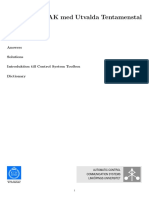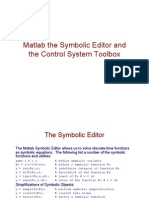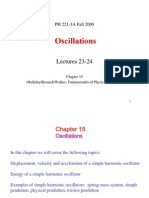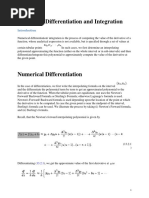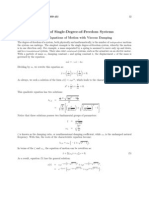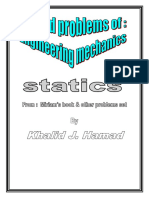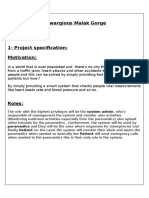Matlab Answers
Uploaded by
Julius RachmanasMatlab Answers
Uploaded by
Julius RachmanasIntroduction to MATLAB
exercises with some example solutions for supervisors
Markus Kuhn
Michaelmas 2006
Exercise 1 Find a short MATLAB expression to build the matrix 1 2 3 4 5 6 7 B = 9 7 5 3 1 1 3 4 8 16 32 64 128 256
Example solution: b = [1:7; 9:-2:-3; 2.^(2:8)]
Exercise 2 Give a MATLAB expression that uses only a single matrix multiplication with B to obtain (a) the sum of columns 5 and 7 of B (b) the last row of B (c) a version of B with rows 2 and 3 swapped
Example solution: (a) b * [0 0 0 0 1 0 1] (b) [0 0 1] * b (c) [1 0 0; 0 0 1; 0 1 0] * b
Exercise 3 Give a MATLAB expression that multiplies two 0 0 1 1 1 2 3 4 5 1 2 3 4 5 (b) the matrix 2 2 (a) the matrix 3 3 1 2 3 4 5 4 4
Example solution: (a) [1 1 1] * (1:5) (b) (0:4) * [1 1 1]
vectors to obtain 0 1 2 3 4
Exercise 4 Modify slide 17 to produce tones of falling frequency instead.
Example solution: Replace f = fmin * (fmax/fmin) .^ l; with f = fmax * (fmin/fmax) .^ l;
Exercise 5 (a) Write down the function g(t) that has the shape of a sine wave that increases linearly in frequency from 0 Hz at t = 0 s to 5 Hz at t = 10 s. (b) Plot the graph of this function using MATLABs plot command. (c) Add to the same gure (this can be achieved using the hold command) in a dierent colour a graph of the same function sampled at 5 Hz, using the stem command. (d) Plot the graph from (c) separately. Try to explain its symmetry (hint: sampling theorem, aliasing).
Example solution: (a) The instantaneous frequency of function g(t) at time t is f (t) = t 5 Hz t = 10 s 2 s2
and since the phase of a sine wave is 2 times the integrated frequency so far, we get
t
g(t) = sin 2
0
f (t ) dt
= sin 2
t2 4 s2
= sin
t2 2 s2
(b+c)
0.8
0.6
0.4
0.2
0.2
0.4
0.6
0.8
10
t = 0:0.01:10; f = sin(pi*t.^2/2); plot(t,f); hold; t2 = 0:1/5:10; stem(t2, sin(pi*t2.^2/2), r); (d) A sine wave with a frequency f larger than half the sampling frequency fs cannot be distinguished based on the sample values from a sine wave of frequency fs f . In other words, the sample values would have looked the same had we replaced the instantaneous frequency f (t) with fs /2 |fs /2 f (t)|, and the latter is symmetric around fs /2, which is in this graph 2.5 Hz and occurs at t = 5 s.
The above is of course just a hand-waving argument, but shall be sucient for this exercise. There are actually a few more conditions fullled here that lead to the exact symmetry of the plot. Firstly, since we started sampling at t = 0 s with fs = 5 Hz, the positions of the sample values end up being symmetric around t = 5 s. Secondly, at the symmetry point t = 5 s, the sine wave was at a symmetric peak from where increasing or decreasing the phase has the same result.
0.8
0.6
0.4
0.2
0.2
0.4
0.6
0.8
10
Exercise 6 Use MATLAB to write an audio waveform (8 kHz sampling frequency) that contains a sequence of nine tones with frequencies 659, 622, 659, 622, 659, 494, 587, 523, and 440 Hz. Then add to this waveform a copy of itself in which every other sample has been multiplied by 1. Play the waveform, write it to a WAV le, and use the specgram command to plot its spectrogram with correctly labelled time and frequency axis.
Example solution:
4000
f = [659 622 659 622 659 494 587 523 440]; fs = 8000; % sampling frequency d = 0.5; % duration per tone t = 0:1/fs:d-1/fs; w = sin(2 * pi * f * t)/2; w = w; w = w(:); w = [w, w .* (mod((1:length(w)), 2) * 2 - 1)]; wavwrite(w, fs, 16, matlab_answer-2.wav); specgram(w, [], fs);
3500
3000
2500 Frequency
2000
1500
1000
500
0 1 2 3 4 Time 5 6 7 8
You might also like
- Combined Loading Exercise Sheet SolutionsNo ratings yetCombined Loading Exercise Sheet Solutions8 pages
- EEE - 321: Signals and Systems Lab Assignment 1No ratings yetEEE - 321: Signals and Systems Lab Assignment 17 pages
- Stock Watson 3u Exercise Solutions Chapter 13 InstructorsNo ratings yetStock Watson 3u Exercise Solutions Chapter 13 Instructors15 pages
- ES 209 Engineering Data Analysis - Long QuizNo ratings yetES 209 Engineering Data Analysis - Long Quiz3 pages
- Numerical Analysis Problems and Solutions PART 1 CH 1 To CH 3No ratings yetNumerical Analysis Problems and Solutions PART 1 CH 1 To CH 399 pages
- DSP Lab Manual 5 Semester Electronics and Communication EngineeringNo ratings yetDSP Lab Manual 5 Semester Electronics and Communication Engineering147 pages
- Matlab Program Using Polynomial RegressionNo ratings yetMatlab Program Using Polynomial Regression4 pages
- Newton-Raphson Method: Numerical AnalysisNo ratings yetNewton-Raphson Method: Numerical Analysis14 pages
- Numerical Differentiation and IntegrationNo ratings yetNumerical Differentiation and Integration17 pages
- Newton's Divided Difference Interpolation FormulaNo ratings yetNewton's Divided Difference Interpolation Formula31 pages
- Three Example Lagrange Multiplier Problems PDFNo ratings yetThree Example Lagrange Multiplier Problems PDF4 pages
- Free Vibration of Single-Degree-Of-freedom SystemsNo ratings yetFree Vibration of Single-Degree-Of-freedom Systems7 pages
- State Feedback Controller Design Using MATLABNo ratings yetState Feedback Controller Design Using MATLAB19 pages
- Theory: Forced Vibration of Two Degrees of Freedom SystemNo ratings yetTheory: Forced Vibration of Two Degrees of Freedom System4 pages
- An Introduction To Solving Engineering Problems With Matlab PDFNo ratings yetAn Introduction To Solving Engineering Problems With Matlab PDF73 pages
- MATLAB Lecture 1. Introduction To MATLABNo ratings yetMATLAB Lecture 1. Introduction To MATLAB5 pages
- Introductory Applications of Partial Differential Equations: With Emphasis on Wave Propagation and DiffusionFrom EverandIntroductory Applications of Partial Differential Equations: With Emphasis on Wave Propagation and DiffusionNo ratings yet
- Introduction To MATLAB - Exercises and Solution Notes: Markus Kuhn Computer Science Tripos - Part IINo ratings yetIntroduction To MATLAB - Exercises and Solution Notes: Markus Kuhn Computer Science Tripos - Part II4 pages
- Lab Experiment 1: Introduction To MATLAB ObjectivesNo ratings yetLab Experiment 1: Introduction To MATLAB Objectives3 pages
- Digital Signal Processing - Exercises: 1 Sequences and SystemsNo ratings yetDigital Signal Processing - Exercises: 1 Sequences and Systems7 pages
- Performance-Related and Skill-Based Pay: An Introduction: ACT/EMP/17No ratings yetPerformance-Related and Skill-Based Pay: An Introduction: ACT/EMP/1744 pages
- MNR School OF Excellence: "Parking Management System"No ratings yetMNR School OF Excellence: "Parking Management System"23 pages
- Why Do Local Governments Return Money To The Treasury?No ratings yetWhy Do Local Governments Return Money To The Treasury?1 page
- Example of A Dissertation Problem Statement100% (1)Example of A Dissertation Problem Statement8 pages
- Archer Avenue St. Patrick's Day Parade 2024No ratings yetArcher Avenue St. Patrick's Day Parade 20242 pages
- Guy Wire Hardware For Set # 1 at Elev 75.00 FTNo ratings yetGuy Wire Hardware For Set # 1 at Elev 75.00 FT1 page
- Ergonomics Intervention Program To Train Water Measurers (Al-Kayyals) For Work at Foggara Irrigation System in AlgeriaNo ratings yetErgonomics Intervention Program To Train Water Measurers (Al-Kayyals) For Work at Foggara Irrigation System in Algeria8 pages
- The System How Companies Get Theri Shit TogetherNo ratings yetThe System How Companies Get Theri Shit Together103 pages
- Patients Safety - Key Issues and ChallengesNo ratings yetPatients Safety - Key Issues and Challenges4 pages
- Stock Watson 3u Exercise Solutions Chapter 13 InstructorsStock Watson 3u Exercise Solutions Chapter 13 Instructors
- Numerical Analysis Problems and Solutions PART 1 CH 1 To CH 3Numerical Analysis Problems and Solutions PART 1 CH 1 To CH 3
- DSP Lab Manual 5 Semester Electronics and Communication EngineeringDSP Lab Manual 5 Semester Electronics and Communication Engineering
- Free Vibration of Single-Degree-Of-freedom SystemsFree Vibration of Single-Degree-Of-freedom Systems
- Theory: Forced Vibration of Two Degrees of Freedom SystemTheory: Forced Vibration of Two Degrees of Freedom System
- An Introduction To Solving Engineering Problems With Matlab PDFAn Introduction To Solving Engineering Problems With Matlab PDF
- Introductory Applications of Partial Differential Equations: With Emphasis on Wave Propagation and DiffusionFrom EverandIntroductory Applications of Partial Differential Equations: With Emphasis on Wave Propagation and Diffusion
- Introduction To MATLAB - Exercises and Solution Notes: Markus Kuhn Computer Science Tripos - Part IIIntroduction To MATLAB - Exercises and Solution Notes: Markus Kuhn Computer Science Tripos - Part II
- Lab Experiment 1: Introduction To MATLAB ObjectivesLab Experiment 1: Introduction To MATLAB Objectives
- Digital Signal Processing - Exercises: 1 Sequences and SystemsDigital Signal Processing - Exercises: 1 Sequences and Systems
- Performance-Related and Skill-Based Pay: An Introduction: ACT/EMP/17Performance-Related and Skill-Based Pay: An Introduction: ACT/EMP/17
- MNR School OF Excellence: "Parking Management System"MNR School OF Excellence: "Parking Management System"
- Why Do Local Governments Return Money To The Treasury?Why Do Local Governments Return Money To The Treasury?
- Ergonomics Intervention Program To Train Water Measurers (Al-Kayyals) For Work at Foggara Irrigation System in AlgeriaErgonomics Intervention Program To Train Water Measurers (Al-Kayyals) For Work at Foggara Irrigation System in Algeria





